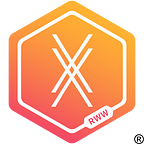Xperiel is the first company combining Augmented Reality and Internet of Things in a meaningful way. What this means is that we’re pushing the Internet out into the real world. We’re making the whole physical world digitally interactive so that people can use the technology around them all the time, just like in sci-fi movies. We’re connecting all the devices in every store, school, and stadium into an interactive digital ecosystem.
This isn’t the World Wide Web (WWW), it’s the Real World Web™ (RWW™), an AR experience of the world around you. The RWW will be the consumer-facing portion of the IoT, and AR will be its UI. The following deeper dive will explain what we mean by this and will hopefully convey our vision of the future.
What is the Real World Web?
There’s something very interesting happening in the intersection between the physical and digital worlds, as shown in the diagram below. The last few years have seen some extraordinary innovation where the digital and physical worlds meet. This is where the Pokemon Go game (one of the fastest-growing apps in history) lives because it uses sensors in the phone to play a real-world digital game with AR capabilities. This is also where Uber (one of the fastest-growing companies in history) lives because you use its mobile application (a digital interface) and then a car comes and picks you up in the real world. The Starbucks app (one of the most successful brand apps) is so valuable precisely because you use it at the brand’s brick-and-mortar cafes by having their baristas physically scan your phone. Google Maps (arguably the most useful app in history) is another great example. All of AR exists in this intersection. So does the entire IoT.
It’s not hard to see that there’s something *really* interesting and powerful going on in this place where the digital and physical meet, and we’re seeing the companies that tap into this power winning — and winning big. We’ve only just started to scratch the surface of what’s possible, and the next 10 years will see a golden age during which we push the Internet out into physical spaces to make the whole world digitally interactive. This will become particularly prescient once augmented reality headsets are perfected and hit their stride. That’s why we’re building the RWW, which is designed to unlock these powers that are currently being monopolized by Pokemon, Uber, and Starbucks, and make them widely-available to everyone. We’re going to make real-world software abilities easily and cheaply available to anyone who wants to build an app. Every coffee house will be able to do what Starbucks is doing, and every brand and sports team will tap into the power of Pokemon Go-like real-world gamification to help entertain and incentivize their customers and fans.
Much like the WWW, the RWW has extremely broad applications that will touch and change all business verticals. We’ve figured out how to unify all hardware and software, past, present, and future, to create physical, digital ecosystems so that every stadium becomes a digital playground and every store becomes a connected smart retailing environment; but even beyond that, they’ll all be part of the same system, so you can start a digital journey using your smartphone (or any mobile device) to interact physically in a cafe. You’ll use it to interact with a television, a cash register, and then in a stadium — that’s the RWW. It’s not an accident that both the IoT and all of AR live in this intersection. The IoT provides all the hardware in the real world, and AR will provide the UI.
Over the next couple of days we will talk about different aspects of Xperiel’s RWW platform, including triggers and Hexalinks™, and our Rox programming language. All of these things make up our unique platform that brings mixed reality experiences to consumers.
